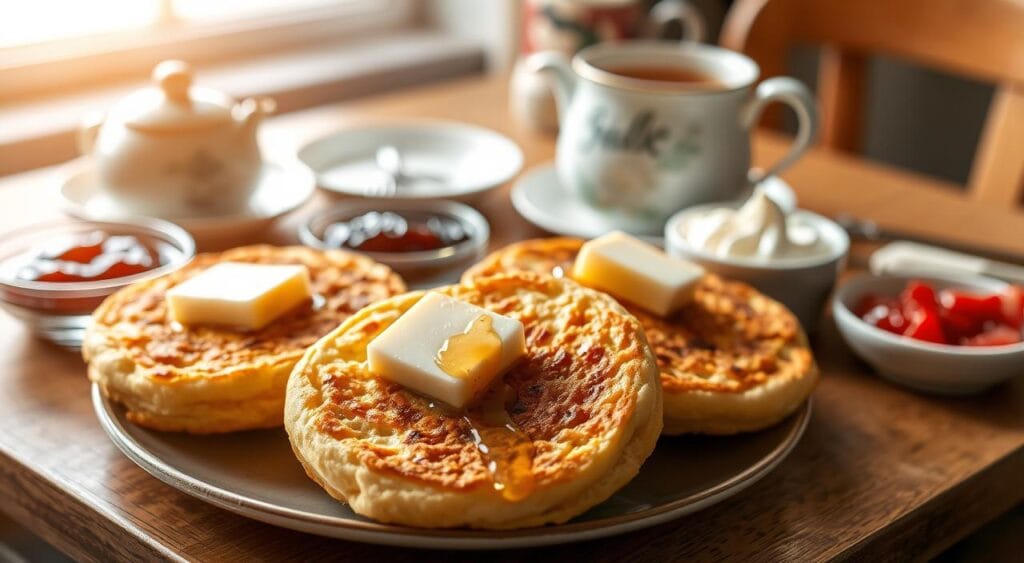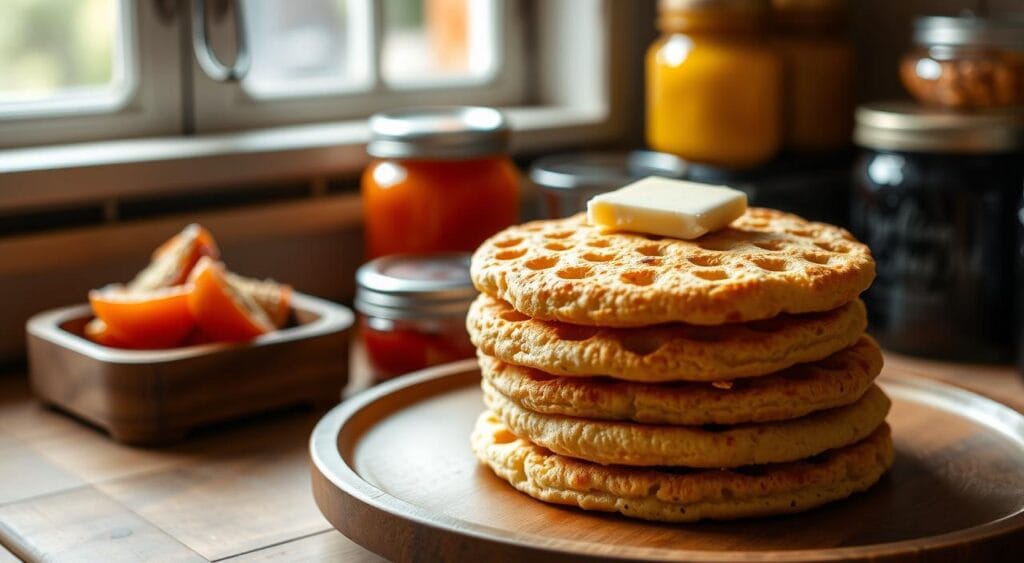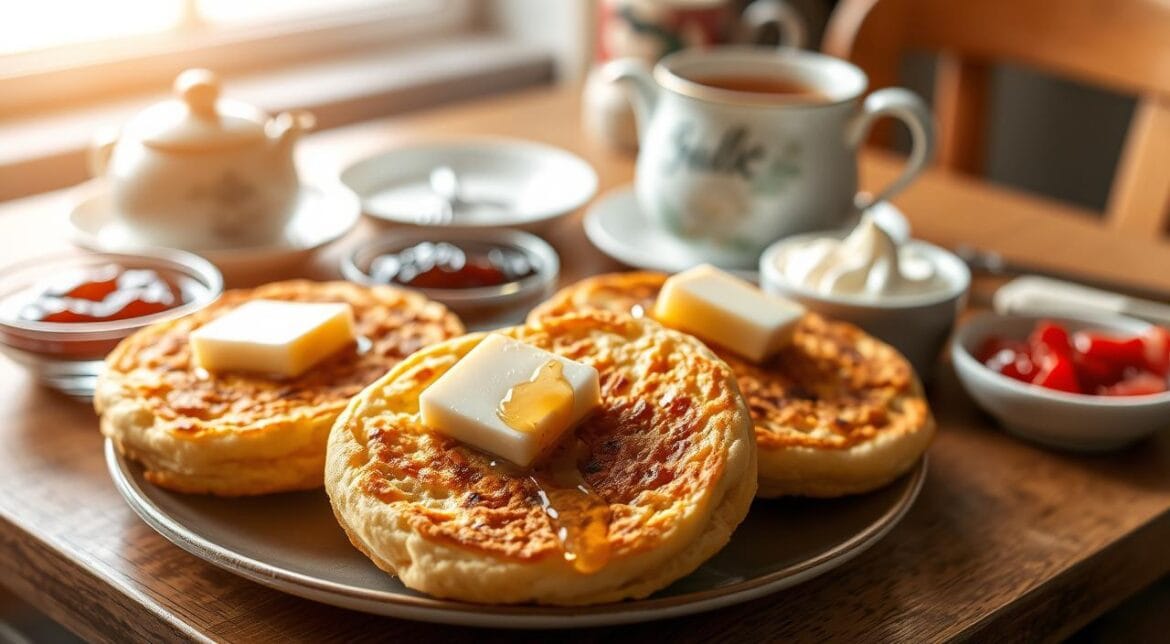Table of Contents
Make your breakfast or tea time special with the classic British crumpet recipe. These soft, spongy treats have won hearts worldwide. With this easy recipe, you can make perfect crumpets at home. It’s great for both experienced bakers and newcomers to British baking.

Key Takeaways
- Discover the cultural significance and history behind the beloved British crumpet
- Learn the essential ingredients and equipment needed to make authentic crumpets at home
- Understand the importance of proper mixing techniques and batter consistency for perfect crumpet texture
- Explore step-by-step instructions for cooking crumpets to golden, spongy perfection
- Troubleshoot common crumpet problems and master the art of serving and storing these delectable treats
Understanding the Classic British Crumpet Tradition
Crumpets are a beloved staple in British cuisine, with a rich history. They have become a cherished part of the country’s culinary heritage. As you explore the world of classic British crumpets, you’ll discover a fascinating story.
Origins and Cultural Significance
The origins of the crumpet date back to the 10th century. They first appeared in English literature. Over the years, crumpets have become a staple in British homes, enjoyed during afternoon tea or breakfast.
Their enduring popularity shows their ability to bring people together. They create a sense of tradition and nostalgia in the British national identity.
What Makes a Perfect Crumpet
The classic British crumpet tradition is all about perfection. A true crumpet lover knows that the perfect crumpet has a unique texture and holes. Great British chefs have worked hard to perfect the recipe and techniques.

“The perfect crumpet is a delicate balance of soft, airy pockets and a subtly crisp exterior, a harmonious blend of textures that delights the senses.”
– Renowned British chef, Gordon Ramsay
Essential Ingredients for Authentic Crumpets
Making the perfect best crumpet recipe begins with the right ingredients. Whether you’re a seasoned baker or new to crumpets, knowing the key ingredients is vital. These ingredients help create the classic texture and flavor of buttermilk crumpets.
The Flour Factor
The base of any crumpet recipe is flour. You’ll need a combination of all-purpose flour and bread flour. The bread flour’s high gluten content is what makes crumpets airy and porous.
Yeast for Lift and Rise
Active dry yeast is what makes crumpets light and fluffy. It works with the other ingredients to create the signature holes and domed shape.
The Dairy Dilemma: Milk or Buttermilk?
- Milk: A classic choice that adds a rich, creamy flavor.
- Buttermilk: Gives a tangy taste and a tender, moist crumb.
Seasoning with Salt
A pinch of salt enhances the flavor. It balances the sweetness and brings out the other ingredients’ nuances.
| Ingredient | Purpose |
|---|---|
| All-purpose flour | Provides structure and texture |
| Bread flour | Contributes to the signature spongy, airy interior |
| Active dry yeast | Leavening agent for rise and lift |
| Milk or buttermilk | Adds moisture, flavor, and richness |
| Salt | Enhances overall flavor profile |
With these ingredients, you’re set to make the perfect best crumpet recipe. Enjoy the authentic taste of homemade buttermilk crumpets. Get ready for a delightful baking adventure!
Required Kitchen Tools and Equipment
Making perfect crumpets needs a few key tools and equipment. Whether you’re an experienced great British chefs or new to cooking, the right tools are crucial. They help you get the crumpet’s unique texture and look.
Crumpet Rings and Alternatives
Crumpet rings are the best for shaping your crumpets. These metal molds create the crumpet’s distinctive round, holey shape. If you can’t find crumpet rings, you can use:
- English muffin rings or cookie cutters
- Repurposed tuna or tomato cans with the tops and bottoms removed
- Silicone or metal rings designed for poaching eggs
Griddle and Pan Options
A heavy-duty griddle or cast-iron skillet is perfect for crumpet recipe. These cookware pieces distribute heat well and keep it steady. This ensures your crumpets cook evenly and get that golden-brown look. If you don’t have these, a non-stick skillet can work, but the results might not be as authentic.
Temperature Control Tools
Keeping the right temperature is key for crumpet recipe success. An instant-read thermometer helps you check the cooking surface’s temperature. You can also use a baking stone or Baking Steel for a stable, even heat.
With the right tools and equipment, you’ll soon master great British chefs crumpet-making.
The Best Crumpet Recipe for Beginners
Making crumpets can seem hard, but it’s easy with the right recipe and tips. We’ll guide you through the best crumpet recipe for beginners. You’ll learn how to make perfect, fluffy crumpets at home.
The secret to great buttermilk crumpets is in the batter. You’ll need buttermilk, flour, baking soda, and sugar. We’ll show you how to mix and rest the batter correctly.
- In a large bowl, whisk together 2 cups of buttermilk, 2 cups of all-purpose flour, 1 teaspoon of baking soda, and 1 tablespoon of sugar.
- Combine the ingredients until they are just blended, making sure not to overmix. The batter should have a slightly lumpy texture.
- Cover the bowl and let the batter rest for at least 30 minutes, or up to 2 hours. This allows the gluten in the flour to relax, resulting in a lighter, fluffier crumpet.
Now, it’s time to cook the crumpets. You’ll need a griddle or nonstick skillet and crumpet rings or round cookie cutters. Heat the pan over medium heat and grease the rings.
Scoop about 1/4 cup of batter into each ring, being careful not to overfill. Cook the crumpets for 5-7 minutes, or until the tops are covered in bubbles and the edges are golden brown. Flip the crumpets and cook for an additional 2-3 minutes, or until the bottoms are also golden.
Serve your freshly made crumpets warm, with your favorite toppings like butter, jam, or honey. Enjoy the perfect balance of crisp edges and soft, fluffy centers that make these crumpets a true delight.
Mastering the Crumpet Batter Consistency
Creating perfect crumpets starts with the right batter consistency. Great British chefs know that the batter’s thickness is key. It affects the crumpets’ texture and how they rise. By getting the batter just right, you can make crumpets that taste like they came from a bakery.
Proper Mixing Techniques
To get the batter just right, mix it gently. Don’t overdo it, or your crumpets will be dense. Stir until the ingredients are just combined, leaving some lumps. This gentle mixing keeps the crumpets light and airy.
Resting Time Guidelines
Letting the batter rest is important. It lets the gluten relax and the batter thicken. Aim for 30 minutes to an hour before cooking. This rest helps create the crumpets’ signature nooks and crannies.
Mastering batter consistency through mixing and resting can take your homemade crumpets to the next level. You’ll be making crumpets as good as the great British chefs.
| Batter Consistency | Mixing Technique | Resting Time |
|---|---|---|
| Ideal | Gentle, avoiding over-mixing | 30 minutes to 1 hour |
| Too Thick | Overmixing, leading to dense texture | Insufficient resting |
| Too Thin | Undermixing, resulting in a runny batter | Excessive resting |
Step-by-Step Cooking Instructions
Learning to make the best crumpet recipe begins with the cooking steps. From heating the griddle to flipping the crumpets, each step is key. This ensures your homemade crumpets are perfect every time.
- Preheat your griddle or non-stick skillet over medium heat. It should be hot enough to sizzle water.
- Lightly grease the crumpet rings or molds with butter or non-stick spray. This helps the crumpets release when cooked.
- Place greased rings on the hot griddle and fill each with batter, leaving a bit of room.
- Cook the crumpets for 5-7 minutes, until the tops are full of holes and the bottoms are golden.
- Flip the crumpets with a fork or tongs and cook for 2-3 minutes more, until lightly browned.
- Take the crumpets off the heat and remove them from the rings. Repeat with the rest of the batter, re-greasing as needed.
By following these steps, you’ll soon master the best crumpet recipe. You’ll make classic British crumpets that are light, airy, and full of flavor.
Troubleshooting Common Crumpet Problems
Making the perfect crumpet is a delicate task. But, with a few simple tips, you can solve common problems. Whether it’s texture or cooking issues, the answers are just a tweak away.
Fixing Texture Problems
If your crumpets are dense instead of light, check the batter’s consistency. Make sure the flour to liquid ratio is right. Adding a bit more water can help thin it out.
Also, avoid over-mixing. This can make the crumpets tough. Over-mixing develops gluten too much.
If your crumpets don’t have holes, let the batter rest longer. This lets the yeast work its magic, creating those holes and pockets.
Addressing Cooking Challenges
Uneven cooking is a common problem. Make sure your griddle or pan is evenly heated. Using crumpet rings can also help the batter keep its shape.
Be patient and don’t flip the crumpets too soon. This can mess up the cooking process.
If crumpets stick to the pan, try greasing the surface lightly. A well-seasoned cast-iron griddle can also prevent sticking.
Remember, the best crumpet recipes come from great British chefs. Don’t be afraid to try new things and find what works for you. With practice and these tips, you’ll soon be making perfect crumpets.
Creative Serving Suggestions and Toppings
Crumpets are great for many toppings and serving ideas. They’re not just for butter and jam. There are so many ways to enjoy them, from simple to fancy.
Try crumpets with caviar for a unique taste. The salty caviar goes well with the soft crumpets. Add some crème fraîche for a fancy touch.
If you like sweet things, top your recipe crumpets with berries, honey, or powdered sugar. The mix of warm crumpets and cool toppings is amazing.
Want something more filling? Layer crumpets with smoked salmon, avocado, and lemon zest. It’s a tasty breakfast or brunch.
- Caviar and crème fraîche
- Fresh berries and honey
- Smoked salmon, avocado, and lemon zest
- Roasted mushrooms and thyme
- Melted brie and cranberry compote
There are countless ways to enjoy crumpets with caviar and other toppings. Experiment with new flavors and ingredients to discover your favorite combination.
Storage Tips and Reheating Methods
Keeping the texture and taste of your best crumpet recipe fresh is key. A few easy steps can help you enjoy these treats for longer. They stay fluffy and golden-brown, just like when they first came out of the oven.
Freezing Guidelines
Freezing is the best way to keep them fresh for longer. Let your best crumpet recipe cool down first. Next, place them in an airtight container or a freezer bag. They can stay good for up to 3 months in the freezer.
When you’re ready to eat them, just thaw them at room temperature. Or, warm them up in the toaster or oven at 350°F for 2-3 minutes.
Best Reheating Practices
- Toaster or Oven: Reheat frozen crumpets in a toaster or preheated oven (350°F) until warmed through and slightly crisp on the outside, about 2-3 minutes.
- Skillet: For a crisper texture, warm thawed or fresh crumpets in a lightly greased skillet over medium heat, flipping occasionally, until heated through.
- Microwave: While not the preferred method, you can quickly reheat crumpets in the microwave for 20-30 seconds, but be mindful of the risk of drying them out.
By using these simple tips, your best crumpet recipe will stay light and airy. You can enjoy the real British taste whenever you want.
Variations on Traditional Crumpets
The classic British crumpet recipe is loved by many. But, there’s room for creative twists. You can add bold flavors or swap ingredients for a healthier treat. Let’s look at some fun ways to make buttermilk crumpets even better.
Buttermilk Crumpets with a Twist
Want to add a special touch? Mix in fresh herbs, spices, or fruits. Buttermilk crumpets with rosemary or black pepper offer a unique taste. Or, add blueberries or pear for a sweet surprise.
Whole Grain Goodness
Want to eat more whole grains? Use whole wheat, oat, or rye flour instead of all-purpose. Crumpets with whole grain flours taste nuttier and are healthier. Play with different mixes to find your favorite.
Crumpets with Caviar
For a fancy crumpet, top them with caviar. The salty caviar complements the crumpet’s softness. It’s a fancy treat for any time.
Crumpets can be many things, from new flavors to healthier options. So, get cooking and make your crumpets extra special.
Conclusion
Making the perfect best crumpet recipe is a rewarding journey. It lets you enjoy the rich history and cultural significance of this beloved British delicacy. By knowing the essential ingredients, key techniques, and troubleshooting tips, you can make tender, fluffy classic British crumpets in your kitchen. They’re ready to be enjoyed with your favorite toppings and warm beverages.
Whether you follow the traditional method or try your own creative variations, making homemade crumpets is joyful. As you get better and explore new possibilities, remember the true essence of this treat. It’s not just about the texture and flavor. It’s also about the shared experiences and memories it brings to family and friends.
So, start baking your own best crumpet recipe today. Let the aromas of freshly cooked crumpets fill your home. Enjoy the satisfaction of serving up a delightful slice of British culinary heritage. Bon appétit!
FAQ
What are the key ingredients for making authentic British crumpets?
To make classic British crumpets, you need flour, yeast, milk or buttermilk, and salt. Flour gives the crumpets their structure. Yeast makes the signature holes. Milk or buttermilk makes them tender and fluffy.
What type of equipment do I need to make crumpets at home?
You’ll need crumpet rings, a griddle or non-stick skillet, and a thermometer. Crumpet rings shape the batter into the classic round form. A griddle or skillet ensures even heating for perfect cooking.
How do I achieve the perfect crumpet batter consistency?
Getting the right batter consistency is crucial. Mix well and let it rest. The batter should be thick but still pourable. Adjusting the flour to liquid ratio helps achieve the perfect consistency.
What are some common crumpet-making problems and how can I fix them?
Common issues include a dense texture, lack of holes, and uneven cooking. To solve these, adjust the batter, ensure the right cooking temperature, and try flipping the crumpets. Patience and practice are essential for making great homemade crumpets.
Can I get creative with crumpet toppings and flavors?
Yes! While classic crumpets are great, you can add your own twist. Try them with jams, honey, butter, cheese, caviar, or smoked salmon. Experimenting with toppings can make your homemade crumpets even more delicious.


2 comments
[…] Posts Crumpet Recipe from Great British Chefs: A Classic… The Best Crumpet Recipe: How to Make Perfect… Authentic Matjesbrötchen Recipe: How to Make the Classic… Step-by-Step Matjesbrötchen Recipe: […]
[…] for Crumpets with Caviar: A Gourmet Twist… Crumpet Recipe from Great British Chefs: A Classic… The Best Crumpet Recipe: How to Make Perfect… Authentic Matjesbrötchen Recipe: How to Make the Classic… Step-by-Step Matjesbrötchen Recipe: […]
Comments are closed.